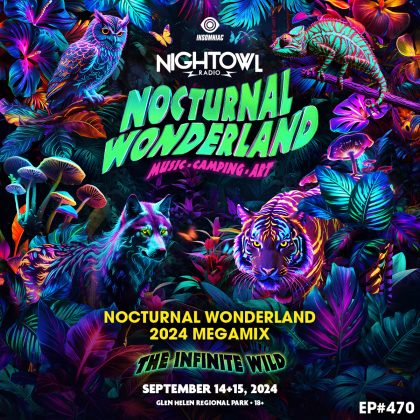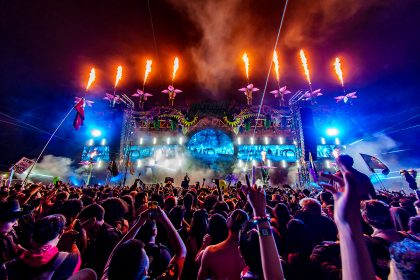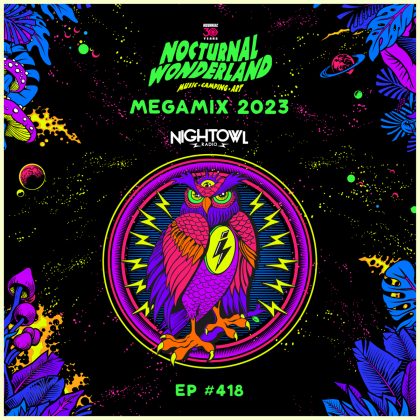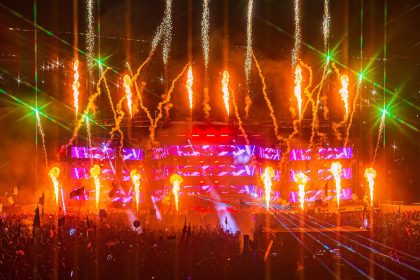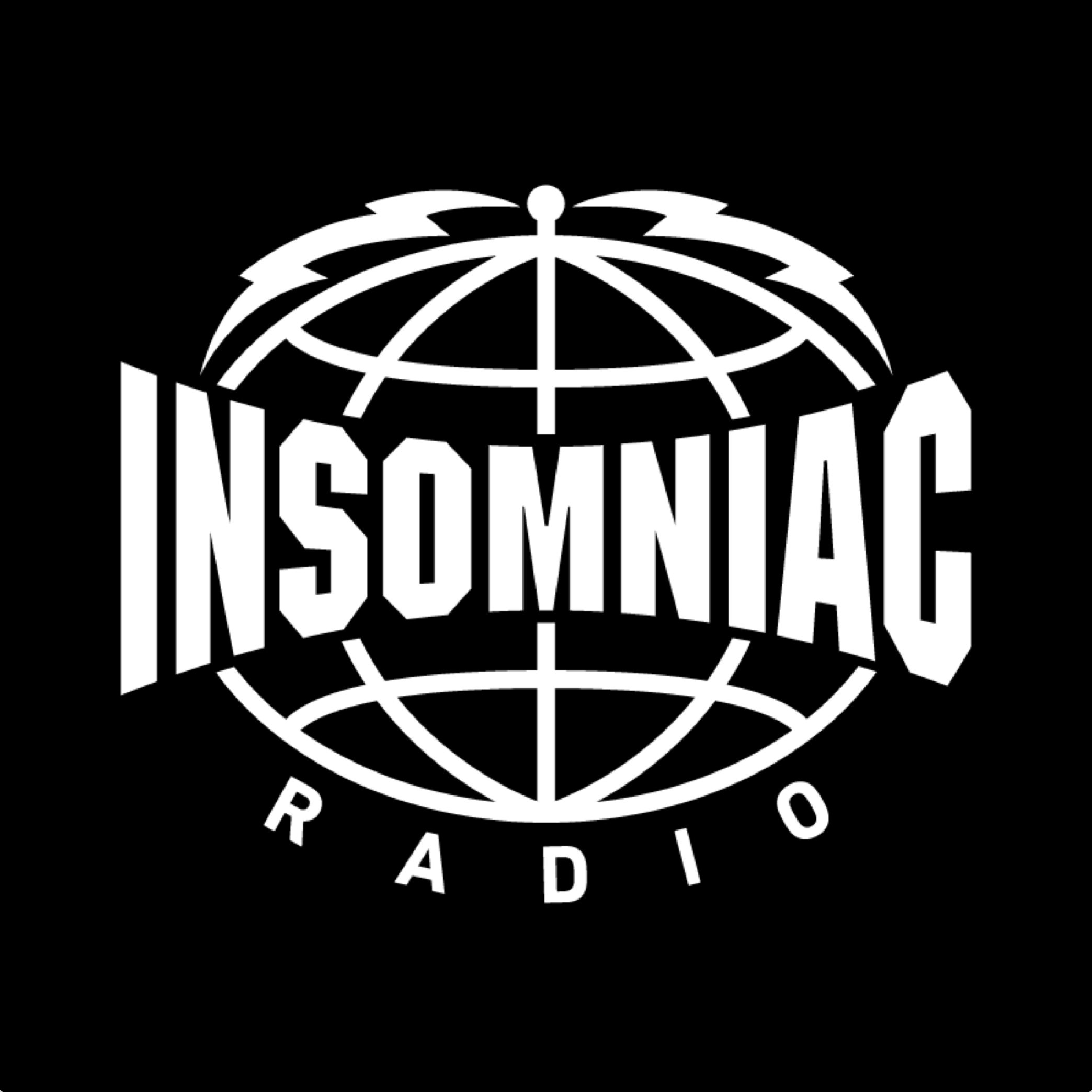Curiouser and Curiouser: The Nocturnal Dream, 20 Years On
I’m walking with my older brother John along a dirt road, then up a long, winding path to a pulsing city on a hill. Passing the gates, we can feel the earth rumble under our feet as Martin Garrix plies his “Animals” from the mainstage. A giant green owl greets us with towering flames under the stars. It’s an escape as well as a homecoming.

We’ve come to see a new generation bask in the summer air, dancing the night away. But there’s an older generation here, too; they’re celebrating many resurrections on a cultural frontier. Smiles and hugs link them together in a spiral of memories: Pasquale Rotella and his cherished late mother, Mama Irene, Bunny Eachon of Rabbit in the Moon, DJ Dan and Donald Glaude of Funky Tekno Tribe, DJ Taylor and Christopher Lawrence, Jenn Harrison of Metropolis, Jessie Brooks of Fresh Produce, George Benitez of Rave Olympia, club queen Rocky Raccoon, and many more.
“In 2001, it was dead. The parties were getting busted, and the crack house law was in full effect. No venues would work with promoters.”
Yet even now, it seems some would still be just as happy to wipe raves right off the face of the earth. It’s never dawned on them that this story was as much about freedom as it was a revolution against artistic complacency. Their anti-quest was no different than a desire to burn the books of Lewis Carroll to ash. No Alice. No Caterpillar. No Cheshire Cat. No Adventures or Looking Glass…
“I never want to do these again. It has only gotten more difficult. There are no options. It might be our last one.”
 So read the words of Rotella’s statement to Lotus Magazine a few days after the sixth Nocturnal Wonderland, in September 2001, just one week before 9/11. The L.A. rave scene had been on a twisting adventure for more than 10 years, including a cat-and-mouse game that took it far into the unknown. It was surreal, sublime and subversive.
So read the words of Rotella’s statement to Lotus Magazine a few days after the sixth Nocturnal Wonderland, in September 2001, just one week before 9/11. The L.A. rave scene had been on a twisting adventure for more than 10 years, including a cat-and-mouse game that took it far into the unknown. It was surreal, sublime and subversive.
In some ways, the location—the Chemehuevi tribal lands at Havasu Landing, near the border of Arizona—was the furthest extreme to which Rotella had yet taken the California rave scene. Just two years before, he had risked his life to find a home for Nocturnal at the Cahuilla Indian Reservation in Anza.
“Infighting within the tribe as to whose land the event would be held on—and thus, who would be compensated—reached a fever pitch,” wrote Rich Thomas for Magnetic Magazine in 2011. “In the end, the payment was shared among the residents, but not before one of them unloaded a shotgun at Rotella’s feet during a particularly touchy meeting.”
It’s hard to believe Nocturnal survived at all. “In 2001, it was dead,” says Rotella. “The parties were getting busted, and the crack house law was in full effect. No venues would work with promoters.”
That vanishing freedom forced Rotella to take his events onto Native American reservations, where US authorities had little jurisdiction.
There would be no Nocturnal the following year. Retreat and soul-searching were in the air. How far were we willing to go? Then came the planes, casting a long shadow across the country that would cripple EDM for years.
“In my memory, we knocked it down, just straight over. But it’s hard to remember, because that’s when the cops shot the tear gas into the crowd.”
“I remember waking up to go get the mail,” says legendary New York DJ Frankie Bones, who played a sunrise set that Nocturnal. “I put the TV on, and they were playing repeats of the planes hitting the buildings. I got on my bike to ride half a mile to a park that overlooked the city. When I got there, I just saw a mushroom cloud in the sky. Everything changed in an instant.”
“All of a sudden, a white cloud envelopes the crowd. The mob panics and starts to stampede. Chris grabs me and presses my face against his chest as the tear gas begins to burn my eyes, nose and throat.”
Three years before the sky went out, Rachel Haigh’s diary painted Nocturnal—held for many years at San Bernardino’s National Orange Show, or NOS—as rave’s frontline. Starting in 1995 and exploding by 1998, Nocturnal was attracting ravers from all over Southern California and beyond.

“We get there, tickets in hand, and there are helicopters circling the parking lot,” she remembers. “Cops on loudspeakers tell us to go home… The crowd is restless and anxious, and the line isn’t moving. Our little group was probably three to six people back from the gate, so we weren’t like, hands on the gate, but we rushed in. The whole crowd did. In my memory, we knocked it down, just straight over. But it’s hard to remember, because that’s when the cops shot the tear gas into the crowd.”
 Inside, hardcore DJ Rob Gee from New York was rocking it. Everyone inside was oblivious to the clash outside, but the energy was no less intense. “I had never seen people jumping into the speakers,” Gee says with a chuckle. “Just all these smiling kids rushing the stacks. In California, they would pile up, fighting to literally crawl inside the bass bins. It was worship of bass.”
Inside, hardcore DJ Rob Gee from New York was rocking it. Everyone inside was oblivious to the clash outside, but the energy was no less intense. “I had never seen people jumping into the speakers,” Gee says with a chuckle. “Just all these smiling kids rushing the stacks. In California, they would pile up, fighting to literally crawl inside the bass bins. It was worship of bass.”
John Dadzie, Skrillex’s mentor and the mastermind behind dubstep act 12th Planet, has gone to every Nocturnal since 1998, where he first heard his hardcore heroes Rob Gee, Ron D. Core and Demigod play live: “For me, there was no stigma of, ‘Oh, you’re not wearing FUBU; you’re not black enough. You don’t listen to Ice Cube; you’re not black enough.’ Society and MTV culture when I was younger had more of an effect on how you were supposed to act, how you were supposed to dress, how you were supposed to conform. What rave culture did for me was completely break that down and strip that away.”
The year before, Haigh experienced something quieter. “I wandered out of one of the big airplane hangar rooms to sit by that little manmade pond and write,” she says, recalling her favorite moment at Nocturnal. “I was sitting by myself, probably wearing gigantic fuzzy pants, hunched over a notebook, and I ran into this boy I’d met a year or two before. We sat there, and we talked by that little pond. I felt really connected to him, and the grass and the stars and the little pond, the ravers wandering around, and the music booming out of every room. I actually stayed in touch with that guy for a number of years. It kicked off a friendship that saw me through some weird times.”
“A good day at the office,” Andy Cato, one-half of Groove Armada, shouted over the beat during their performance at Nocturnal Wonderland 2000. “A good day indeed.”

 So reported the Los Angeles Times, noting Groove Armada’s positive house as a high point at the summer festival. Insomniac had worked hard to secure Coachella’s grassy Empire Polo Field. It was the biggest tent yet raised on America’s rave frontier. Away from smoke and sorrow, like Haigh’s reflection by the water, Nocturnal 2000 was a vision of a better world.
So reported the Los Angeles Times, noting Groove Armada’s positive house as a high point at the summer festival. Insomniac had worked hard to secure Coachella’s grassy Empire Polo Field. It was the biggest tent yet raised on America’s rave frontier. Away from smoke and sorrow, like Haigh’s reflection by the water, Nocturnal 2000 was a vision of a better world.
“To see a massive on those fields, and all the people there, was mind-blowing,” says Tim Acquarelli of Orange County. “The thing that made them so great were the lineups. This one was ridiculous. There was everything.”
“Since we were in the desert, it seemed like every star in the universe was shining that night,” says Gabriel Esparza of Burbank. “There was this moment when I was lying on my back on the grass, staring up at the sky. At that moment, I was at peace and felt this connection with everybody, which I could not explain… When the last song was done and the music stopped, all you could hear was the roar of the crowd screaming with excitement, of how much of an epic party it was.”
“It was dead silent. Then someone started whistling, and the party erupted again. You didn’t want it to end.”

“Everyone is walking to their cars,” says Candace Dickerson, who was part of Acquarelli’s O.C. crew. “It was dead silent. People were exhausted. Then someone started whistling, and the party erupted again. People were talking and singing and playing music from their car stereos. You didn’t want it to end.”
“In L.A., we were lucky to have a lot of cool warehouses and abandoned buildings that became our playground,” says DJ legend Ron D. Core of Nocturnal’s roots, who played that same 2000 peak. “A lot of that fueled our mystique. It escalated, and people fell in love with going to an unknown location.”
“We have honed our own unique style from the rest of the pack,” he continues, tying that love back to sound. “It is more raw. The music being made and played was limitless. You heard everything at parties here. Anything goes. Nothing got pushed to the wayside.”
A decade later at Nocturnal, 12th Planet helped usher in a new era for EDM, playing right after the French electro house of Kavinsky. “I opened up with this scene from the film Network,” says Dadzie. “He’s screaming, ‘I’m mad as hell, and I’m not going to take this anymore!’ I remember everyone screaming and going fucking nuts… Everyone rushed the stage, and that whole tent got fucking packed, and I thought, maybe this dubstep thing is going to be pretty big in L.A.”
“Wake up, Alice dear!” said her sister. “Why, what a long sleep you’ve had!”
“Oh, I’ve had such a curious dream!” said Alice.

Looking back, it was a search for humanity that kept it all going. Rotella could have walked away after the nightmares of 2001. But he didn’t, and who can fault him now? Nocturnal was like Alice herself, meandering through years of adventure to strange and beautiful places, breaking through the microchip mirror of our electronic age.
“I like stuff that has history. And the longer the history, the more sentimental, the more memories there are.”
“I felt transcended,” recalls Dadzie of his early Nocturnal days, long before he dropped down as 12th Planet. “I’m a child of the night—no boundaries for what the real world has. The reason why I made more friends through that culture, there was more of a common bond. If you were there, you know it. Let’s say you pass someone on the street; the thing you have in common with them is you raged for 14 hours together.”

“It was my first baby,” Rotella echoes. “I went through a lot to keep it alive. It was my biggest brand for a couple years. It’s the longest-running brand in America. I like stuff that has history. And the longer the history, the more sentimental, the more memories there are.”
Standing with my brother among the Nocturnal alumni last year on that warm summer night, there was gratitude that somehow rave culture had pushed through to the other side. “Everybody there just loved the music and loved the scene and just believed in the whole thing,” says John, who first broke out as one of Moontribe’s first resident DJs and regularly played both EDC and Nocturnal. “And frankly, I think that was something Pasquale liked about the people he booked. Everyone was just really into it.”
“Someone had to put L.A. on the map in the electronic dance music world,” he says, looking forward. “It’s where it’s supposed to be. Now, it’s a new generation with new heroes. It’s just natural. That’s just where things go.”
And so round and round, from darkness to light, day and night, on and off we go. The next 20 trips round the sun unfold before us now like a winding rabbit road—or as Bones tells it, “Once we figure out how to tie all the past to the present, that’s when the future gets here.”

